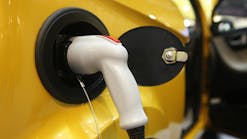Idling regulations in the United States range from ambiguous to California-strict. Depending on the area, time spent complying with idling rules means additional paperwork, inspections and fees—more costs, more hassles. David Nus, director of customer solutions for Volvo Construction Equipment, has a different perspective. He suggests that a well-conceived idling policy is an opportunity to reduce operating costs. And he can prove it.
The Impact of Excessive Idling
A contractor plans to own a machine for five years, operates the machine 2,000 engine hours per year, and employs the same operator. Data collected from the onboard information system shows this machine burns an average of one gallon of fuel per hour while idling.
If the operator cuts idle time in half to 25 percent by shutting the engine down during lunch and breaks, over a 5-year period the contractor will:
• Save 500 engine hours
• Save between 5-10 percent on routine servicing
• Improve the machine’s resale or trade-in value based on 7,500 hours, not 10,000 hours
• Require 5 fewer standard 500-hour servicings
• Extend the warranty based on fewer engine hours
• Save at least $9,625* in fuel savings (this figure does not reflect probable fuel cost increases over 5 years.)Extend this example to a contractor running three similar machines on the same job, and annual fuel saving approaches $30,000.
“Everyone knows things like fuel consumption and idle time ought to be minimized. It’s like mom and apple pie,” Nus says. But contractors and equipment managers want to be able to accurately gauge the effectiveness of steps they are taking to run green and clean.
Percent of shift spent idling 50% 25% Total annual idling hours 1,000 500
Idle time fuel cost ($3.85/gal. $3,850 $1,925 Cumulative idling fuel cost (5 yrs) $19,250 $9,625 Estimated engine hours at resale 10,000 7,500 Number of 500-hour servicings 20 15
“Costs and savings can be measured in many ways, but folks like simple rules of thumb,” Nus says. “Fuel consumption is fairly easy to measure with onboard systems, and we find the fuel consumption data is a great proxy for overall cost of work and, presumably, fuel efficiency. It is tangible information one can track and manage, and use to focus upon for improvement.
“When you ‘do the math’ and put a dollar cost against what is happening in the field, it really opens more eyes and reinforces that there is an opportunity to squeeze more cost out of the diesel emission lemon.”
Determining the impact of idling is a simple equation using data already being collected by newer equipment that uses telematics to log engine data.
Hands-on key to idle-time reduction
Mechanical controls and software programs are helping manage the variables that affect idling efficiency. Equipment manufacturers are implementing idle reduction technology, including auto idle functions that sense inactivity and automatically drop the engine speed to a lower idle, and load-sensing hydraulics that spring into action on demand only. Equipment managers are using engine-health data to schedule more preventive maintenance procedures. But the variable that has the most impact on idling is the human at the controls.
Idle-reduction training should include specific operating practices, defined goals, business benefits, and objective feedback. Presenting reasons for idle-reduction rules from several perspectives such as environmental impact, immediate safety of co-workers, legal responsibilities, and cost savings gives operators stronger motivation to adapt their performance to meet the company’s policy. Training operators how to work with the equipment’s capabilities according to the manufacturer’s guidelines helps maximize the operator’s satisfaction with his efforts and increases productivity. Using quantifiable data to measure improvement clarifies what the contractor is asking of his operators and defines management expectations. Reinforcing operator performance with incentives based on meeting measurable goals, such as bonuses based on fuel operating costs saved, helps support continued operator buy-in.
Training Points
The U.S. Environmental Protection Agency suggests idle-reduction training include these points:
• Limit idle time at shutoff. Older engines need two-minute shutdown, new engines need almost none.
• Turn off dump trucks that are waiting longer than five minutes to load or unload.
• Restrict morning warm-ups to three to five minutes (check with manufacturer).
• Turn off equipment when not in use.
• Use the automatic vehicle shutdown function when available.
• Anticipate the mobile requirements of other vehicles and trades, and position the inactive vehicle where it won’t impede the movement of other equipment.
Knowledge and attitude adjustment also figure into idle-reduction training. Nus says one of the biggest impediments to managing idle-reduction behavior is an old operating mentality that is based on the operator’s experience with pre-EPA engines.
“Some operators still think the engine has to be screaming, with lots of smoke, for the machine to really work,” he says. “But technology in today’s machines doesn’t work that way.” Educating operators on both how and why to run their machines in specific ways goes a long way to change old attitudes.
Gary Beerbower, western region heavy equipment manager for Waste Management, recognized changes coming in emissions rules and started working toward compliance several years before CARB regulations were in place.
“We started in 2008 really moving toward taking steps to meet regulations that would go into effect in 2010,” Beerbower says. “During that process in 2009, we had to implement an idling policy—which was a good thing because we recognized we were idling way too much.” Beerbower says the company expanded its idle policy to cover 13 other states in the western part of the United States.
Waste Management’s western area employs approximately 1,000 operators. The measurable results of WM’s idle policy are significant fuel savings and operators seeing better machine performance.
“We’re saving about 10 percent of our fuel cost,” Beerbower says. “We started with our company average idle time at 30 percent, and our goal is to get everyone below 20 percent. Currently, we are at an average of 15 to 20 percent idle time.
“One thing we are able to do is go back and show our operators who are experiencing problems with a piece of equipment the effect idling has on engines with particulate filters,” he says. “Idling plugs up those filters real fast and is many times the cause of the problem.”
Idle-reduction training can be toolbox-talk casual or formal, and it can be supported with resources provided by manufacturers, dealers, consulting firms and trade associations.
“Results from training will vary by every site,” Nus says. “It is easy to not give idling much thought. After all, the machine is at low rpm and not burning much fuel, right? But when you consider the total amount of time spent idling, the fuel burned starts to add up and might make the difference between a viable company and one that goes out of business.”
Download: Here





